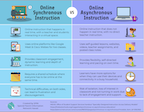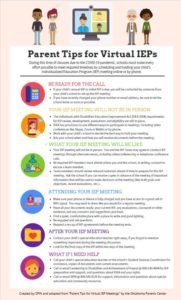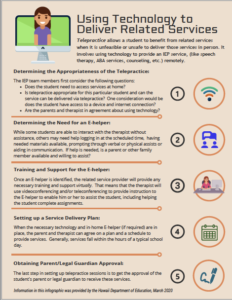The COVID-19 pandemic has had a huge impact on the delivery of special education services in Hawaii and nationally. School closures necessary to guarantee the health and safety of students and staff have resulted in many students losing skills. Once school resumed, IEPs teams have been instructed to meet and assess each student’s needs. The following infographics were designed to help families be informed partners in the IEP process. Mahalo to the Department of Education, the Special Education Advisory Council, the Community Children’s Council Office, the Leadership in Disability & Achievement of Hawaii and the State Council on Developmental Disabilities for helping to ensure the accuracy and improve the readability of these informational tools.
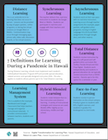
7 Definitions for Learning During a Pandemic in Hawaii. In order for schools and parents to be clear about what kinds of instruction will be provided to students with disabilities, they need to have the same understanding of terms used in describing distance learning. This infographic defines what is meant by various terms for school instructional models and types of online learning. It was developed in partnership with the Exceptional Support Branch of the Department of Education, so that parents and educators can speak the same language in the IEP process. Click
here for a copy of the infographic.
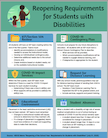
Reopening Requirements for Students With Disabilities. This infographic outlines the considerations required of the IEP team when reviewing the student’s academic and behavioral status upon the reopening of school for the new school year. These include whether to consider student absences a change of placement, developing a COVID-19 Contingency Plan, assessing the need for COVID-19 Impact Services, maintaining the student’s LRE and developing a Total Distance Learning Plan when parents opt not to send their child onto the school campus for classes. Click
here for a copy of the infographic.
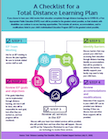
A Checklist for a Total Distance Learning Plan. When a parent chooses to have their child receive his or her education completely through distance learning because of COVID-19, the IEP team must go through a process to determine if the IEP goals and objectives can be implemented through distance learning. This helps to ensure that FAPE will be provided to the greatest extent possible from home. Click
here for a copy of the infographic.
School Closure Contingency Plan Checklist. Given the unpredictable nature of the coronavirus and natural disasters, IEP Teams are helping to prepare a contingency plan for how a student will continue to make progress on his or her IEP objectives and goals should the school have to close completely for a period of time. Part of the planning process is to identify any barriers to learning and address them through accommodations and modifications as well as supports to the parent. Click
here for a copy of the info
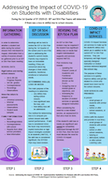
Addressing the Impact of COVID-19 on Students with Disabilities. Many if not most students with disabilities experienced a loss in skills due to the closure of schools and all must be assessed upon returning to schools to determine the degree of loss. The process for determining how to best address the loss includes gathering information, holding an IEP meeting, and potentially revising specially designed instruction and related services through the IEP or offering COVID-19 Impact Services. These are temporary and intense services offered outside of the school day. Click
here for a copy of the infographic.
Online Learning Options. When students are receiving instruction through the use of a tablet, laptop or phone, it is either in real time with a teacher or therapist (synchronous), or without the teacher present in real time (asynchronous). Both options offer different benefits and potential drawbacks. Click
here for a copy of the infographic.
Parent Tips for Virtual IEPs. This infographic was adapted from one created by the Oklahoma Parent Center. It helps parents anticipate and prepare for an IEP meeting where the meeting is not held in person, but rather through videoconferencing or a telephone conference call. Click
here for a copy of the infographic.
Using Technology to Deliver Related Services. Telepractice is the name given to using technology to provide an IEP service remotely like speech therapy, counseling and ABA services. Prior to delivering telepractice services, the IEP team must determine the following: the appropriateness of the service for the student, whether the student has access to a device and internet connection, the availability of an E-helper, and any necessary support and training for the E-helper. Click
here for a copy of the infographic.






